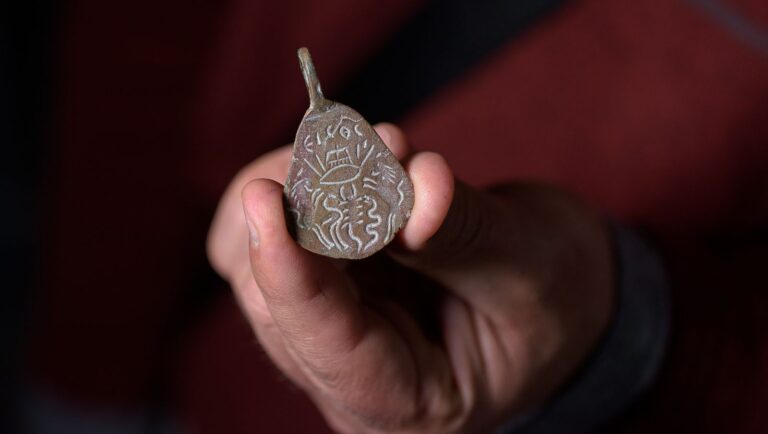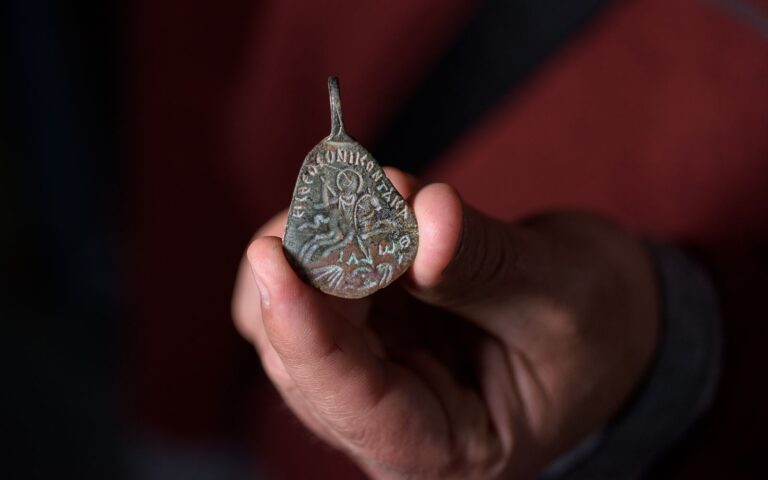JERUSALEM, Israel – A double-sided bronze amulet found near the ancient Byzantine-era synagogue of Arbel close to 40 years ago was recently donated to the Israeli National Treasures Center and the Israel Antiquities Authority.
The area where the amulet was originally found in northern Israel is just a few miles west of the Sea of Galilee, and roughly 20 miles south of the Lebanese border. The Ancient Synagogue of Arbel was located on Mount Arbel and constructed in the 4th century.

Ruins of the Ancient Synagogue Arbel – Image credit: Bukvoed – CC BY 3.0
The front of the bronze amulet depicts a rider on a galloping horse bearing a spear that is being thrust in the direction of a female figure on the ground. The rider also is depicted with a halo around their head. Beneath the rider and above the female figure on the ground are the Greek letters, I A W Θ, which stand for the Jewish Divine Name (Yahweh, IHYH). An inscription, also in Greek, is engraved in a semicircle above the rider and reads, “The One God who Conquers Evil.”
The reverse side of the amulet features an eye that is “pierced by arrows and by a forked object.” Directly beneath the eye is a scorpion flanked by a bird on the left and a snake on the right, and then framed by two lions in a rampant pose, one on either side. At the top of the amulet are Greek letters that researchers say are the abbreviation of ένας θεός meaning “One God.”
Deputy Director of the Antiquities Theft Prevention Unit, Dr. Eitan Klein, who conducted the research on the amulet said, “[T]he amulet is part of a group of fifth–sixth-century CE amulets from the Levant that were probably produced in the Galilee and Lebanon. This group of amulets is sometimes called ‘Solomon’s Seal,’ and the rider is depicted overcoming the evil spirit – in this case, a female-identified with the mythological figure Gello/Gyllou, who threatens women and children and is associated with the evil eye. The eye on the reverse is identifiable as the evil eye, being attacked and vanquished by various means. Therefore, the amulet was probably used to guard against the evil eye, possibly to protect women and children.”
In Greek mythology, “Gello/Gyllou” refers to a female demon who can harm women by interfering in reproduction, causing infertility, miscarriage, and even infant mortality. However, in the Byzantine era, the “gelloudes” (γελλούδες) were considered to be a class of beings. A woman who was believed to be under the influence of demonic possession by gelloudes could be forced to undergo an exorcism or even be brought to stand trial.
The origin of the Gello is uncertain, but it possibly is derived from the name “Gallû,” which refers to a Babylonian–Assyrian demon thought to bring sickness and death. Gallû may also be the root for the word ghoul.
Ben, a practicing orthodox Jew and Israeli who immigrated to the U.S. in the early 2000s told TWH that typical modern use of protective amulets would not have any type of figures or pictures on them, only Hebrew script.
Arbel as a Jewish settlement during the Byzantine era supported a linen-production industry that was important in the Talmudic period and governed by Jewish agrarian laws. As such, it would have had a variety of sages who would have visited and taught within the settlement.
When asked who might have worn the amulet, and whether they might be Jewish or not, Klein replied, “I can’t determine that. On the contrary! Anti-demon pendants of this type were used by everyone at the time – Jews, Christians and gnostics – who existed here.”
Klein continued, “Gnostics used Yahweh’s name. The name of the Jewish god was accepted by everybody who lived here then. It was a powerful name in its divinity. One didn’t have to be a Jew to believe in the power of the name.”
“Although scholars generally identify the wearers of such amulets as Christians or Gnostics, the fact that the amulet was found within a Jewish settlement containing a synagogue in the fifth-sixth centuries CE may indicate that even Jews of the period wore amulets of this type for protection against the evil eye and demons,” Klein said.

Ruins of Arbel Synagogue – Image credit: Yael Alef – CC BY-SA 3.0,
Ben, a practicing orthodox Jew and Israeli who immigrated to the U.S. in the late 90s told TWH that any typical modern use of protective amulets would not have any type of figures or pictures on them, only Hebrew script.
The idea of the “evil eye,” or the ability of a magical practitioner to cause misfortune or harm by merely meeting their gaze, is a belief that is found across many cultures around the globe and throughout time and history.
While it may be impossible to know who wore the amulet or exactly what faith they might have ascribed to, protection from malignant magic, especially for women who were either pregnant or just hoping to start a family was possibly universal.
The Wild Hunt is not responsible for links to external content.
To join a conversation on this post:
Visit our The Wild Hunt subreddit! Point your favorite browser to https://www.reddit.com/r/The_Wild_Hunt_News/, then click “JOIN”. Make sure to click the bell, too, to be notified of new articles posted to our subreddit.


